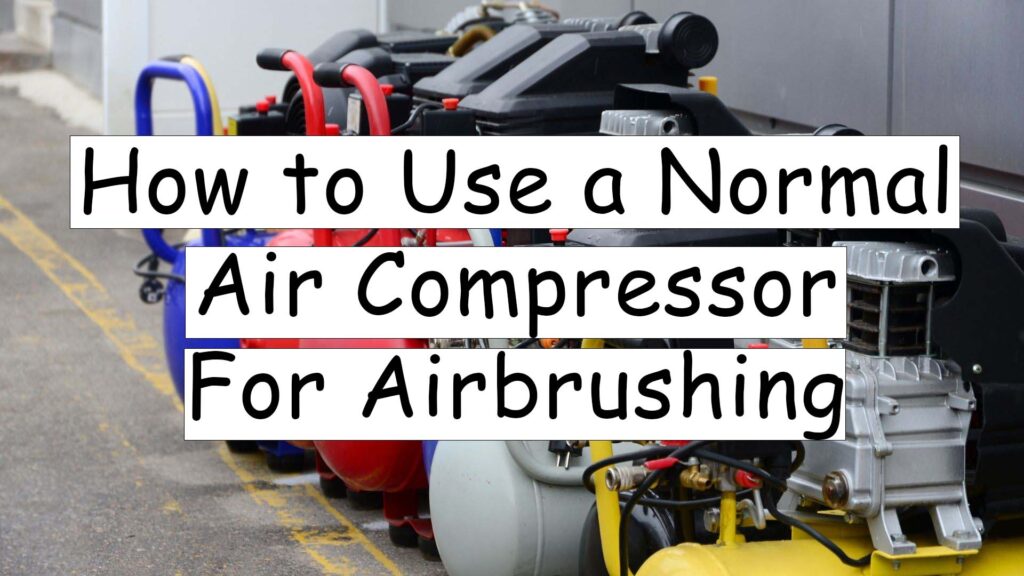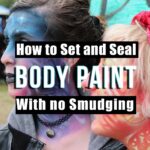Normal air compressors are often far cheaper than airbrush-specific brand compressors. For the air output performance, they’re almost always a better deal apples to apples.
But how different are normal air compressors from their brand-name counterparts? I wondered this exact question myself and have experimented over the years to see if you can use a normal air compressor for airbrushing just the same as you’d use a brand name one.
In general, normal air compressors will work for airbrushing. Most normal shop air compressors deliver enough air pressure to atomize paint particles in the airbrush. Although normal air compressors are usually cheaper and more durable, airbrush-specific compressors often feature more precise air regulators, built-in moisture traps, and quieter operation.
I’ve personally used a normal air compressor for my airbrush body painting work and for large applications over many years. They’re a good alternative to more expensive airbrushing-specific compressors when you don’t mind the noise, you need to lay down lots of paint, or you’re using it in a dirty and chaotic environment.
This article is all about using normal air compressors for airbrushing:
- the pros and cons,
- how to hook up your airbrush, and
- recommendations for picking a normal air compressor for airbrushing.

The Pros and Cons of Using a Normal Air Compressor for Airbrushing
Normal air compressors are very similar to the airbrush-specific brands that you see for sale on Amazon.com or at your local art store.
Check out this article about the best air compressors for airbrushing for a breakdown of the best brand-name models.
ARTICLE: 5 Best Airbrush Compressors: An Artists Honest Review
At the end of the day, all an airbrush needs to work properly is a steady stream of air delivered through the hose and through its air passage. Therefore, a normal shop compressor will perform this task just fine with some slight differences.
Here are the pros and cons of using a normal air compressor for airbrushing:
Pros:
- Cheaper
- More durable
- Higher pressure output
Cons:
- Less precise air regulator
- No moisture trap
- Louder
Generally speaking, airbrush-specific air compressors have finely tuned components like air regulators, quiet motors, and built-in moisture traps.
The air regulator gives you fine control over the air pressure output from the compressor.
The moisture trap ensures that airflow is dry even in humid climates – making the paint stream stick more consistently and with better adhesion properties to the substrate.
With normal shop air compressors, you’re typically dealing with loud motors, no built-in moisture traps, and with less precise air regulator valves.
These are definitely cons, but you can justify the downside with cost savings for similar air output, less fragile bells & whistles, and the option of in-line moisture traps.
How to Hook Up an Airbrush to a Normal Air Compressor

To hook up an airbrush to your normal air compressor, you’ll need to connect your airbrush hose to the compressor fitting. I’ve found that the best way to do this is with a quick-connect air fitting.
What you’ll need:
- Teflon tape
- 1/4 inch NPT quick connect fitting (specific to the compressor)
- Airbrush hose with a 1/4 inch NPT thread on the compressor side
NOTE: The most common size of quick connect air fitting in the US is a 1/4 inch NPT (National Pipe Thread).
NPT refers to the standard taper of piping threads in the US. Some airbrush hoses use BSP (British Standard Pipe) threading.
Always match the quick connect thread type (either NPT or BSP) with the airbrush hose thread type so they will connect properly.
If you already have an airbrush hose or compressor that have different thread types, you can get an adaptor to fix this problem.
BSP to NPT Threading Airbrush Compressor and Hose Adaptor
NOTE: Airbrush hoses are specific for the airbrush. For example, an Iwata Airbrush Hose will fit Iwata airbrushes but not Paache airbrushes. A Paache Airbrush Hose will fit Paache airbrushes but not Iwata airbrushes. For most smaller brand-name airbrushes, 1/8 inch hose couplings are the most common size.
Always match the airbrush with the airbrush hose connection type so that they fit together (match like brands together).
Here’s step-by-step instructions on how to connect an airbrush to a normal air compressor:
STEP 1: Wrap quick connect threads with teflon tape.
STEP 2: Screw the quick connect fitting into the 1/4 inch end of the airbrush hose.
STEP 3: Insert the quick connect into the air compressor.
STEP 4: Screw the 1/8 inch end of the airbrush hose into the air compressor.
Once your airbrush hose is connected, turn on your air compressor to charge it up. Listen carefully for air leaks coming from the quick-connect fitting. If you don’t hear anything, you’re good to go!
Best Normal Air Compressor for Airbrushing
As I mentioned in this other article about the best airbrush air compressors, there are 5 important features to look for in an air compressor:
- Air Output
- Holding tank
- Noise level
- Portability (weight)
- Durability
These same features are also applicable for picking a normal air compressor for airbrushing.
Best Normal Air Compressor For Airbrushing | Craftsman 6 Gallon Pancake Compressor w. Accessories
If you want a compact normal air compressor that you can take everywhere, the Craftsman 6 Gallon Pancake is your pick. It includes an accessory kit that gives you everything you need to hook up to the airbrush hose immediately.
| Craftsman 6 Gallon Pancake Compressor Features | |
|---|---|
| Air Output | 2.6 SCFM at 90 PSI |
| Holding Tank | 6 Gallons |
| Noise Level | 78.5 Decibels |
| Weight | 32.5 Pounds |
| Durability | High Durability |
2.6 SCFM at 90 PSI is plenty of air pressure for any airbrush application. It also features a 6-gallon holding tank that’s important to give the motor a break and prevent overheating.
The 2 quick-connect outlets allow you to connect 2 hoses at once if you ever want to rock dual airbrushes. It’s light enough to carry everywhere and built with a rugged design so it won’t break with some bangs and bumps during transportation.
Overall, this air compressor will give you the same performance that a premium airbrush-specific compressor can achieve at a much lower price. Sure it will be much louder, but it has everything you need to plugin, start airbrushing right away, and all in a compact transportable package.
Airbrushing gear is a joy to buy when you’re really getting into the art form. But for some, it doesn’t make sense to drop a few hundred bones on a fancy compressor if you’re just starting out.
I used an old beat-up air compressor from Home Depot for years before finally investing in an airbrush-specific model.
Moisture traps, air regulators, and quiet motors are nice to have, but the important thing is that you’re getting some air into your airbrush and making some paint fly. So to that end, get the normal air compressor, and get after it!




